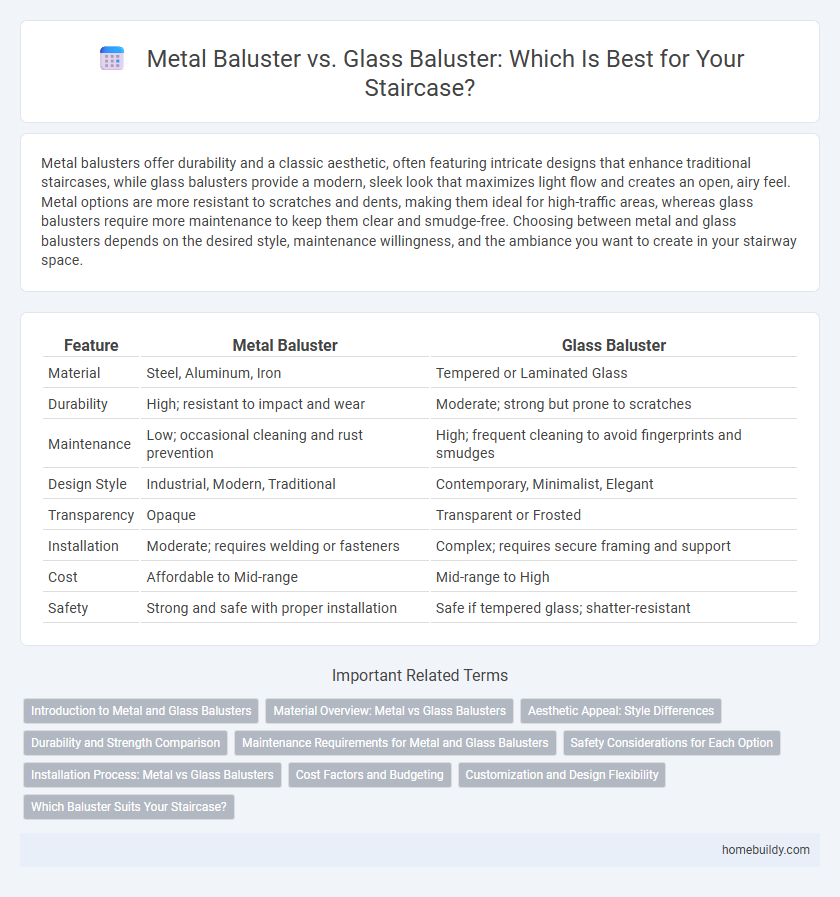Metal balusters offer durability and a classic aesthetic, often featuring intricate designs that enhance traditional staircases, while glass balusters provide a modern, sleek look that maximizes light flow and creates an open, airy feel. Metal options are more resistant to scratches and dents, making them ideal for high-traffic areas, whereas glass balusters require more maintenance to keep them clear and smudge-free. Choosing between metal and glass balusters depends on the desired style, maintenance willingness, and the ambiance you want to create in your stairway space.
Table of Comparison
| Feature | Metal Baluster | Glass Baluster |
|---|---|---|
| Material | Steel, Aluminum, Iron | Tempered or Laminated Glass |
| Durability | High; resistant to impact and wear | Moderate; strong but prone to scratches |
| Maintenance | Low; occasional cleaning and rust prevention | High; frequent cleaning to avoid fingerprints and smudges |
| Design Style | Industrial, Modern, Traditional | Contemporary, Minimalist, Elegant |
| Transparency | Opaque | Transparent or Frosted |
| Installation | Moderate; requires welding or fasteners | Complex; requires secure framing and support |
| Cost | Affordable to Mid-range | Mid-range to High |
| Safety | Strong and safe with proper installation | Safe if tempered glass; shatter-resistant |
Introduction to Metal and Glass Balusters
Metal balusters offer durability and a classic aesthetic, often crafted from wrought iron, steel, or aluminum with various finishes to complement traditional or modern staircases. Glass balusters provide a sleek, contemporary look, enhancing light flow and creating an open, airy feel while maintaining safety with tempered or laminated glass panels. Both options deliver structural support and style, with metal emphasizing strength and intricate designs, and glass prioritizing transparency and minimalism.
Material Overview: Metal vs Glass Balusters
Metal balusters offer exceptional durability, strength, and a variety of finishes such as wrought iron, stainless steel, or aluminum that complement both traditional and modern stair designs. Glass balusters provide a sleek, contemporary aesthetic with transparent or frosted panels that enhance natural light and create an open, airy feel in staircases. While metal balusters excel in structural support and intricate design options, glass balusters prioritize visual elegance and spatial openness, making material choice dependent on style preference and functional requirements.
Aesthetic Appeal: Style Differences
Metal balusters offer a classic, industrial aesthetic with sleek lines and a variety of finishes such as wrought iron or brushed steel, making them ideal for traditional and modern stair designs. Glass balusters provide a contemporary, minimalist look with transparent panels that enhance natural light and create an open, airy feel in any space. The choice between metal and glass balusters directly affects the staircase's visual impact, with metal emphasizing sturdy elegance and glass promoting visual openness and sophistication.
Durability and Strength Comparison
Metal balusters, typically made from wrought iron or steel, offer superior durability and strength compared to glass balusters, making them ideal for high-traffic areas and load-bearing applications. Glass balusters, while aesthetically appealing and providing a modern look, are more susceptible to cracking and chipping under impact and generally require tempered or laminated glass to enhance their structural integrity. The inherent robustness of metal balusters ensures long-term stability and minimal maintenance, whereas glass balusters demand careful handling and periodic inspections to maintain safety standards.
Maintenance Requirements for Metal and Glass Balusters
Metal balusters require regular cleaning to prevent rust and corrosion, especially in outdoor settings, and periodic inspection to maintain paint or finish integrity. Glass balusters demand frequent cleaning to avoid fingerprints, smudges, and water spots, using non-abrasive cleaners to preserve clarity. Both materials benefit from routine maintenance, but metal may involve protective coatings whereas glass requires careful handling to prevent scratches and breakage.
Safety Considerations for Each Option
Metal balusters provide strong structural support and resist impact, making them a safer choice for high-traffic areas or homes with children and pets. Glass balusters, while aesthetically appealing, require tempered or laminated safety glass to reduce the risk of breakage and injury. Proper installation and regular maintenance are essential for both materials to ensure long-term safety and durability.
Installation Process: Metal vs Glass Balusters
The installation process for metal balusters typically involves welding or screwing into place, offering robust durability and easier adjustments during fitting. Glass balusters require precise measurements and specialized hardware like clamps or channels to securely hold the glass panels without damage, demanding more careful handling. Metal balusters often allow faster installation, while glass balusters emphasize aesthetic appeal alongside safety compliance.
Cost Factors and Budgeting
Metal balusters generally offer a more cost-effective solution compared to glass balusters due to lower material and installation expenses. Glass balusters, while providing a sleek and modern aesthetic, tend to require higher upfront investment and maintenance costs, impacting overall budgeting decisions. Choosing between metal and glass balusters largely depends on balancing initial price points with desired design impact and long-term upkeep budget.
Customization and Design Flexibility
Metal balusters offer exceptional customization through various finishes, shapes, and intricate patterns, allowing for tailored design aesthetics in staircases. Glass balusters provide sleek, modern transparency but have limited shape options, primarily focusing on thickness and tint variations. Choosing metal balusters maximizes design flexibility for both contemporary and traditional styles, while glass balusters enhance light flow and openness with minimalist customization.
Which Baluster Suits Your Staircase?
Metal balusters offer durability and a classic aesthetic suitable for traditional or industrial-style staircases, providing strong support and customization options with various finishes. Glass balusters create a sleek, modern look that enhances natural light and visually expands space, ideal for contemporary or minimalist designs. Choosing between metal and glass balusters depends on the stair design, safety requirements, and desired ambiance, balancing style with functionality.
metal baluster vs glass baluster Infographic

 homebuildy.com
homebuildy.com